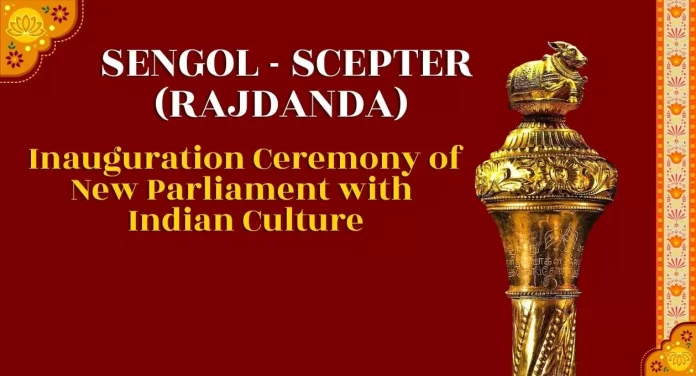What is going to happen in the inauguration ceremony of the new Parliament House? Its main attraction is the Sengol Scepter – a symbol of Indian culture that shares historical significance with India and is deeply connected to religion, philosophy, law and order.
India, Jambudweep, Bharatkhand, Himvarsha, Ajnabhavarsha, Bharatvarsha, Aryavarta, Hind, Hindustan has been a vast country since ancient times. In which people associated with different beliefs and practices have been living. Whenever there is a change of state power or someone has coronated the king, then everyone has been following their own traditions. Sengol Scepter (Rajdanda) shares historical significance with India and it is closely related to religion, philosophy law and order.
This Sengol Scepter (Rajdanda) is mainly depicted in the hands of Hindu deities, especially those associated with governance, protection and justice. It represents his divine rule and authority over the universe. The sign is often decorated with intricate carvings, gems, or other sacred symbols that enhance its symbolic significance.
For example, Lord Vishnu, the protector of the universe, is often referred to as Kaumodaki. This secret represents his authority and power to maintain cosmic order and protect the world. Similarly, Lord Shiva, the destroyer and the transformer, is depicted holding the trident, which symbolizes his supreme power and ability to transcend the three aspects of existence – creation, preservation, and destruction.
Similarly a character can be seen in the hand of Lord Brahma, it is called Brahmadanda. It is also associated with monarchs and rulers in Hindu culture and is often depicted as a royal symbol in their hands. It shows his authority, sovereignty and ability to rule justly.
What we see today as segol is actually a club because, the word sengol is derived from the Tamil words sen which means right or fair, and from gol referring to a spear. In Tamil culture, a high priest would hand over a sign to a new king upon his rise to power. It also represents the authority and responsibility assigned to the leaders to rule with righteousness.
The symbolism of sengol goes beyond its physical representation. This reflects the importance of leaders being fair, transparent and accountable in their decision-making processes. It represents inclusivity, where leaders are expected to listen to diverse viewpoints, promote social justice, and ensure equal opportunities for all.

Sengol (Scepter) History of Ancient Dynasties of India
From ancient India to the medieval period, all the empires that emerged on the land of India have used Sengol Scepter (Rajdanda) in their respective periods. According to historians, the first known use of Sengol Scepter (Rajdanda) in India was by the Maurya Empire (322–185 BCE). It has since been used by the Gupta Empire, the Chola Empire and the Vijayanagara Empire.
In ancient times, the Sengol (scepter) was used by great dynasties to show their authority over their vast empires. It was seen as the power and symbol of the ruler. It was made of gold or silver and decorated with precious stones.
According to Professor S. Rajavelu
Former Tamil University professor S. Rajavelu According to this Sengol Scepter (Rajdanda) was a traditional practice from time immemorial for Acharyas (spiritual gurus) to lead the coronation of kings and consecrate the transfer of power. This practice gives recognition to the ruler as Kshashan.
Sengol (scepter) is considered a symbol of heritage and tradition in the South Indian state of Tamil Nadu. The scepter became a symbol of Sengol’s power. Derived from the word Semmai, which means excellence in Tamil, Sengol signifies power and authority. It is about five feet tall and has a Nandi bull on it, which represents the element of justice and justice.
When a new king ascends the throne, the king is traditionally presented with a scepter by the high priest. The Sengol scepter is still considered a symbol of the transferable power and authority of the Indian monarch. Along with being a symbol of India’s glorious history, it is also considered a symbol of the country’s independence.
Professor S. Rajavelu said that the Tamil kings had this Sengol (Tamil word for scepter) in use which is considered a symbol of justice and good governance. Two epics – Silapathikaram and Manimekalai make special mention about the importance of Sengol (scepter). The scepter has been used since time immemorial. The Tamil poem Tirukkural has a chapter on Sengol (scepter) in detail.
Professor S. Rajavelu said that the Acharya, head of the ancient Saivite monastery Thiruvvaduthurai Adinam Matha, had presented the Sengol (scepter) to India’s first Prime Minister, Pandit Jawaharlal Nehru, in 1947 before he ascended the throne. Because India has its own traditions, beliefs which are very important to follow. The transfer of power should be led by a spiritual leader as per Indian culture and tradition.
The Sengol (Scepter) is an important historical symbol associated with India’s independence from the earliest times. Traditionally, Sengol was used as a symbol of the power of transfer when the British declared India independent.

